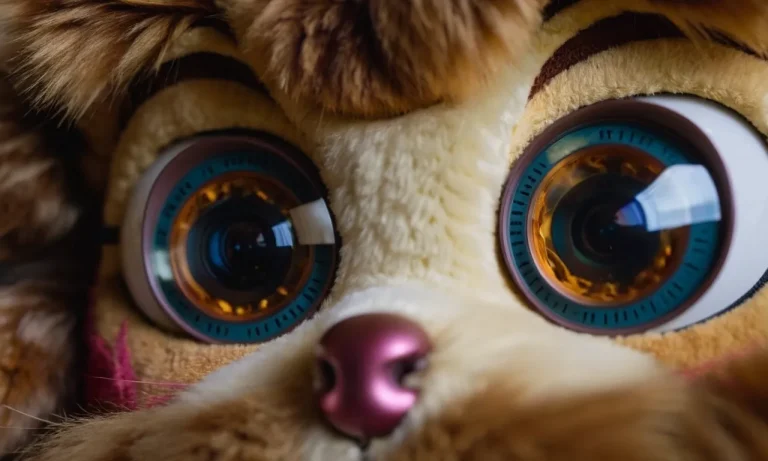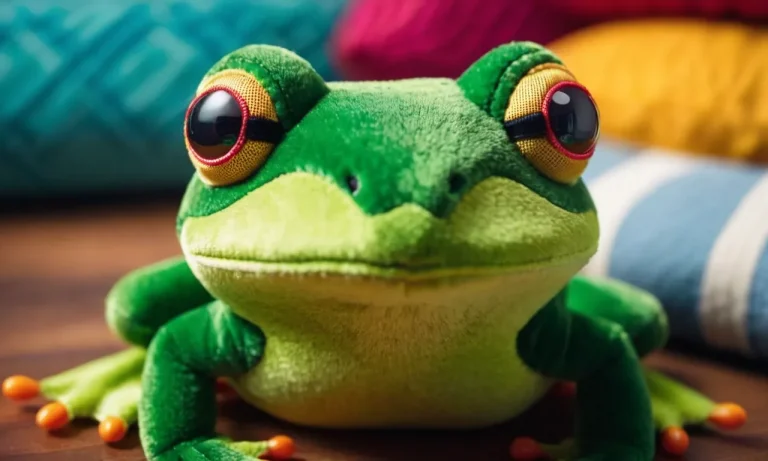Do you have a beloved stuffed animal collection that seems to have taken over your home? A handmade macrame stuffed animal hammock is the perfect solution to corrall and display your plushie friends. The airy, open weave allows them to be viewed and accessed easily while keeping them organized and out of the way.
If you’re short on time, here’s the quick answer to making your own macrame stuffed animal hammock: Gather supplies like cotton rope, a dowel, clamps, and scissors. Cut lengths of rope for your desired hammock size and use lark’s head knots to secure the ropes to the dowel.
Create the hammock weave using square knots, being sure to pull each knot tight. Hang using hooks screwed into studs or use command hooks for easier installation and removal.
Planning Your Macrame Stuffed Animal Hammock
Choosing a Location with Proper Support
When choosing where to hang your cute DIY macrame stuffed animal hammock, make sure you select a location that has sturdy anchoring points to properly support the weight of your stuffed critters (😊). Look for studs in walls or robust hooks in ceilings to attach your hammock.
You’ll want it super secure so you don’t have to deal with any unexpected spills of plushies! If installing new hardware, follow manufacturer’s instructions carefully.
We recommend sites away from high traffic areas so your display doesn’t get bumped. Windowsills, the corner of bedroom walls, or the inside of closet doors make great spots to showcase your menagerie of snuggly friends.
Selecting Your Materials
Now comes the fun part – picking out materials! 👏 For macrame cord, opt for thickness that suits the size of your project plus the weight of stuffies that will lounge within. A popular option is 3mm to 6mm cord constructed from cotton, hemp, jute or nylon since they have some stretch and “grip” to hold shape.
Match colors to your stuffed animals or décor for a coordinated look.
As for stuffies themselves, gather up an armload of your favorites from bears to bunnies and more for a eclectic mix. Tip: look for ones made of soft, plush fabrics that feel oh-so-good to touch for prime snuggling!
Measuring for Size
Determining the right sized hammock ensures all your stuffies fit while keeping proportions balanced. Lay them out in potential groupings so you can visually gauge space needed. Using a flexible tape measure, assess both width and length.
Jot down the largest dimensions and add 2-4 inches for a comfortable lounging area within the strands.
For the overall macrame project square footage as you tie knots, estimate triple the interior measurements. This allows for the braided tails and edge fringe detailing for that natural bohemian vibe. Soon you’ll have a swinging seat ready for the whole cuddle crew! 😍
Preparing and Hanging the Dowel Rod
Cutting the Dowel to Length
When making a macrame stuffed animal hammock, an important step is preparing and installing the dowel rod that will serve as the base. First, measure the area where you plan to hang the hammock and cut the dowel rod accordingly.
Make sure to leave a few extra inches on each end to allow for the macrame knots and hanging hardware.
Use a handsaw, miter box, or ask your local hardware store to cut the dowel for you. Cutting it precisely to the right length will give your hammock a tidy, professional look. If possible, sand the cut edges of the dowel so there are no rough patches.
This will allow the macrame cord to glide smoothly over the surface as you tie knots around the rod.
Securing with Clamps and Screwing in Hooks
With your custom-sized dowel rod ready, it’s time to install hanging hardware. Start by positioning folded towels or other padding on a flat work surface – this will protect the dowel when you apply clamps.
Place the dowel on the padding and secure both ends using strong bar clamps or quick grip clamps. The clamped padding helps grip the dowel so it doesn’t spin when you screw in eye hooks or cup hooks.
Pre-drill pilot holes if you’re using standard wood screws for your hanging hardware. For extra strength, opt for hooks with wood screw backs rather than nails. Space the cup hooks evenly along the underside of the dowel rod – try placing one near each end and another in the center.
Make sure screws are tight so hooks remain securely fastened as stuffed animals are loaded into the hammock.
| Dowel Rod Length | Hanging Hardware |
| Cut 1-2 inches longer than hanging area | Eye hooks, cup hooks with wood screw backs |
Once your hooks are installed on the prepped dowel rod, congratulations – this piece of hardware is ready for macrame magic! When knotting your cord around the dowel, be sure to position knots snugly next to each hook for stability.
As the hammock takes shape, imagine the delighted faces of children when they first load their favorite stuffed pals into the cozy nest you are creating!
For more guidance on supplies and specific tying techniques for stuffed animal hammocks, check out these step-by-step tutorials:
- https://www.thesprucecrafts.com/how-to-make-a-macrame-hammock-4686606
- https://www.homedit.com/diy-macrame/
Attaching the Rope Ends
Using Lark’s Head Knots
One of the most secure knots for attaching the rope ends of your macrame stuffed animal hammock is the Lark’s Head knot. This versatile knot creates a loop that won’t loosen or slip, making it perfect for hanging the hammock between two stationary objects like bed posts or tree branches.
Here’s a step-by-step guide to tying Lark’s Head knots:
- Fold the rope end in half to create a loop and lay this loop over the post or branch you’ll be attaching it to.
- Thread the ends of the rope through the loop from back to front.
- Pull both ends of the rope through the loop tightly to secure it in place.
You can tie one Lark’s Head knot on each end of the main rope that will form the backbone of your hammock. Check out this helpful 1-minute YouTube tutorial on tying Lark’s Head Knots to see it in action.
Spacing Ropes Evenly
Once you’ve secured both ends of the base rope for your hammock using Lark’s Head knots, it’s time to add the macrame rope detailing that will form the actual bed of the hammock.
Start by anchoring ropes perpendicular to the main rope using Half Hitch knots spaced evenly apart. A good rule of thumb is to leave about 2.5 – 5 cm between ropes for a tight, sturdy foundation. You can always add more length between knots if a looser weave is desired once the initial ropes are in place.
As you’re knotting each horizontal rope into place, be sure to gently pull and adjust to distribute them evenly across the main rope. Use a tape measure periodically to check spacing, or simply eyeball the distance between knots as you develop your macrame skills!
The width of the hammock will depend on the number of horizontal ropes attached. For tiny hammocks suitable for smaller stuffed animals, six ropes may suffice. Bigger stuffed friends will need a wider, more heavy-duty hammock of 10-12 horizontal ropes or more.
Feel free to get creative with mixing up rope widths, colors and textures for a unique look. Just maintain even spacing between the horizontal ropes for the optimal amount of cozy support!
Weaving the Macrame Pattern
Basic Square Knots
One of the most fundamental knots used in macramé is the square knot. To tie a basic square knot:
- Take two equal lengths of cord and lay them parallel, with the right cord on top of the left.
- Take the outer right cord and cross it over the inner left cord to form an x shape in the middle.
- Take the new “outer left cord” and cross it under the new “inner right cord.
“
- Pull both cords tight to secure the knot.
Repeat this process, alternating which cord starts on top, to create rows of square knots. Keeping the knots uniform and snug against each other will result in a tight, durable weave for the hammock.
Achieving Tight, Uniform Weave
Maintaining consistent tension is crucial for a professional-looking macramé project with a sturdy, structured shape like a hammock. As you work, periodically stop to gently pull the cords tight from both sides of knots you’ve already tied before continuing to add more.
Also, avoid allowing excess slack in the cords between knots. Keeping extra cord length to a minimum ensures the knots sit neat and compact. Finally, use cord of the same thickness and try knotting with cord still attached to full spools instead of pre-cut lengths.
This provides continuous tension that naturally keeps knots uniform and prevents unwanted loosening over time. Follow these tips for gorgeous, lasting macramé!
Finishing Touches
Trimming Ends
Once your macrame stuffed animal hammock is complete, it’s time for some finishing touches to polish it up. First, trim any excess rope ends so there are no long fraying pieces. Use sharp scissors to cut the ends of the rope cleanly.
Leave about a half inch of rope end and avoid cutting the knots themselves. This gives your hammock a tidy, professional look. You’ll have a cleanly crafted macrame masterpiece! Trimming the ends this way is an important step to ensure safety and durability.
Optionally, you can singe the rope ends with a lighter or candle flame to seal them and prevent further fraying. Just be very careful not to actually burn the rope. Singing is not required, but can make the ends last longer if you plan to hang up your hammock often.
Optional Add-ons Like Fringe or Beads
Personalize your hammock with fun embellishments! Fringe or tasseled rope along the bottom edge adds flair and texture. Simply tie or glue strands of suede cord, yarn, or other skinny rope. Get creative with varying lengths for an organic look. Fringe catches the light beautifully!
Adding 18-20 strands of fringe can take a basic hammock to the next level.😊
Wood beads, natural stones, or sea glass are pretty accents too. Tie them in clusters where hammock ropes intersect using clear thread or thin twine. Vary shapes and colors for lots of visual interest. Just be sure any beads are securely fastened since little hands may be all over the hammock!
| Add-on | Good For | Considerations |
|---|---|---|
| Fringe | Texture, flair | May fray over time |
| Beads | Color, visual appeal | Secure carefully for safety |
When selecting any additional trims or embellishments, ensure they do not present safety issues like loose small parts for children/pets. Check that all elements are firmly secured. Now stand back and admire your hammock! It’s sure to become a beloved spot for snuggling stuffed friends. 👏
Conclusion
Displaying your stuffed animal collection in a handmade macrame hammock is a fun DIY project that adds personality to any space. After planning the size, preparing the dowel rod for hanging, and knotting together the rope weave, you’ll have a custom creation to organize and show off your most treasured plushies.
Just be sure to use sturdy materials, evenly space ropes, pull knots tight, and properly hang the rod for safety. Add your own decorative touches like fringe or beads too. Enjoy your new stuffed animal hammock!







